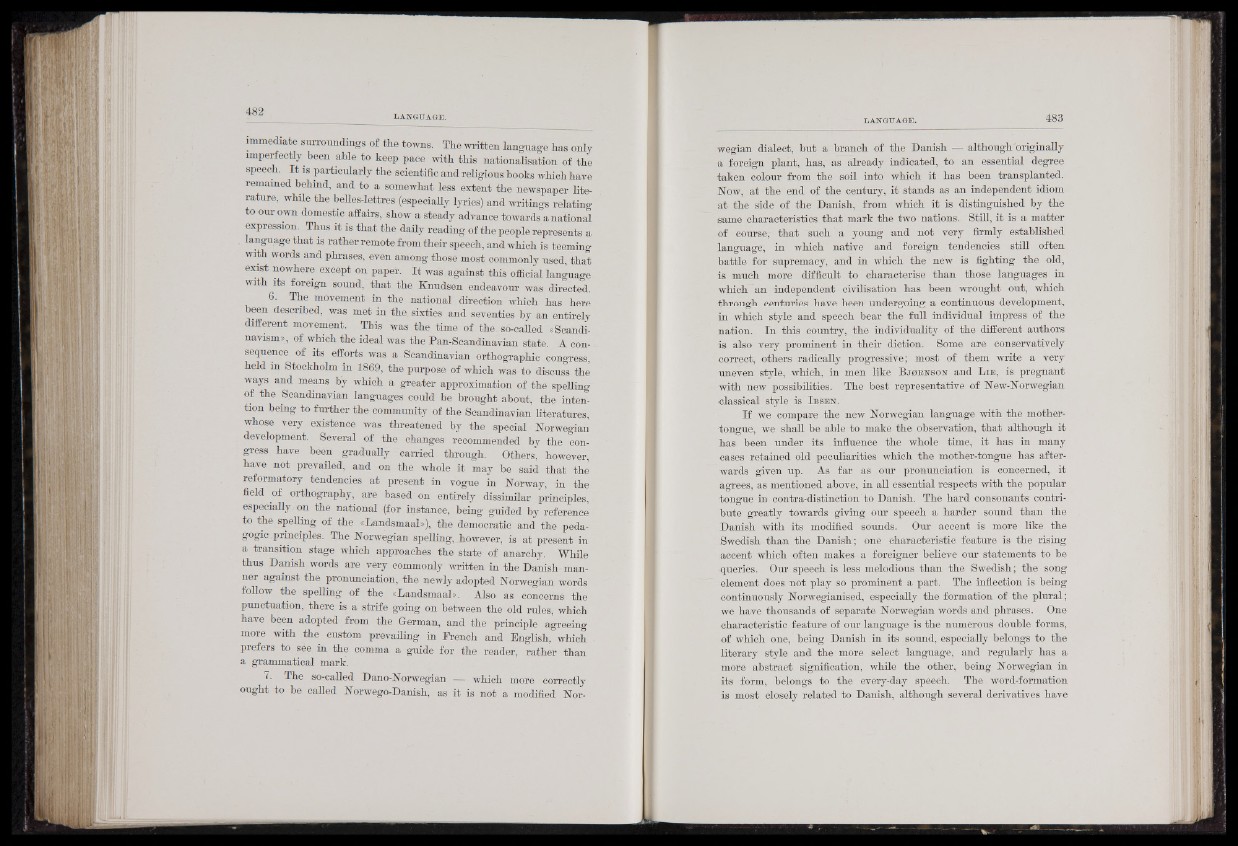
immediate surroundings of tie towns. The written language has only
imperfectly been able to keep pace with this nationalisation of the
speech. I t is particularly the scientific and religious books which have
remamed behind, and to a somewhat less extent the newspaper literature,
while the belles-lettres (especially lyrics) and writings relating
to our own domestic affairs, show a steady advance towards a national
expression. Thus it is that the daily reading of the people represents a
language that is rather remote from their speech, and which is teeming
with words and phrases, even among those most commonly used, that
exist nowhere except on paper. I t was against this official language
with its foreign sound, that the Enudsen endeavour was directed.
6. The movement in the national direction which has here
been described, was met in the. sixties and seventies by an entirely
different movement. This was the time of the so-called «Scandinavian
», of which the ideal was the Pan-Scandinavian state. A consequence
of its efforts was a Scandinavian orthographic congress,
held in Stockholm in 1869, the purpose of which was to discuss the
ways and means by which a greater approximation of the spelling
of the Scandinavian languages could be brought about, the intention
being to further the community of the Scandinavian literatures,
whose very existence was threatened by the special Norwegian
development. Several of the changes recommended by the congress
have been gradually carried through. Others, however,
have not prevailed, and on the whole it may be said that the
reformatory tendencies at present in vogue in Norway, in the
field of orthography, are based on entirely dissimilar principles,
especially on the national (for instance, being guided by reference
to the spelling of the «Landsmaal»), the democratic and the pedagogic
principles. The Norwegian spelling, Jhowever, is at present in
a transition stage which approaches the state of anarchy. While
thus Danish words are very commonly written in the Danish manner
against the pronunciation, the newly adopted Norwegian words
follow the spelling of the «Landsmaal»:. Also as concerns the
punctuation, there is a strife going on between the old rules, which
have been adopted from the German, and the principle agreeing
more with the custom prevailing in French and English, which
prefers to see in the comma a guide for the reader, rather tiia.n
a grammatical mark.
7. The so-called Dano-Norwegian — which more correctly
ought to be called Norwego-Danish, as it is not a modified Norwegian
dialect, but a branch of the Danish — although originally
a foreign plant, has, as already indicated, to an essential degree
taken colour from the soil into which it has been transplanted.
Now, at the end of the century, it stands as an independent idiom
at the side of the Danish, from which it is distinguished by the
same characteristics that mark the two nations. Still, it is a matter
of course," that such a young and not very firmly established
language, in which native and foreign tendencies still often
battle for supremacy, and in which the new is fighting the old,
is much more difficult to characterise than those languages in
which an independent civilisation has been wrought out, which
through centuries have been undergoing a continuous development,
in which style and speech bear the full individual impress of the
nation. In this country, the individuality of the different authors
is also very prominent in their diction. Some are conservatively
correct, others radically progressive; most of them write a very
"uneven style, which, in men like B.i o r n s o .n and Lib, is pregnant
with new possibilities. The best representative of New-Norwegian
classical style is I b s e u .
If we compare the new Norwegian language with the mother-
tongue, we shall be able to make the observation, that although it
has been under its influence the whole time, it has in many
cases retained old peculiarities which the mother-tongue has afterwards
given up. As far as our pronunciation is concerned, it
agrees, as mentioned above, in all essential respects with the popular
tongue in contra-distinction to Danish. The hard consonants contribute
greatly towards giving our speech a harder sound than the
Danish with its modified sounds. Our accent is more like the
Swedish than the Danish; one characteristic feature is the rising
accent which often makes a foreigner believe our statements to be
queries. Our speech is less melodious than the Swedish; the song
element does not play so prominent a part. The inflection is being
continuously Norwegianised, especially the formation of the plural;
we have thousands of separate Norwegian words and phrases. One
characteristic feature of our language is the numerous double forms,
of which one, being Danish in its sound, especially belongs to the
literary style and the more select language, and regularly has a
more abstract signification, while the other, being Norwegian in
its form, belongs to the every-day speech. The word-formation
is most closely related to Danish, although several derivatives have